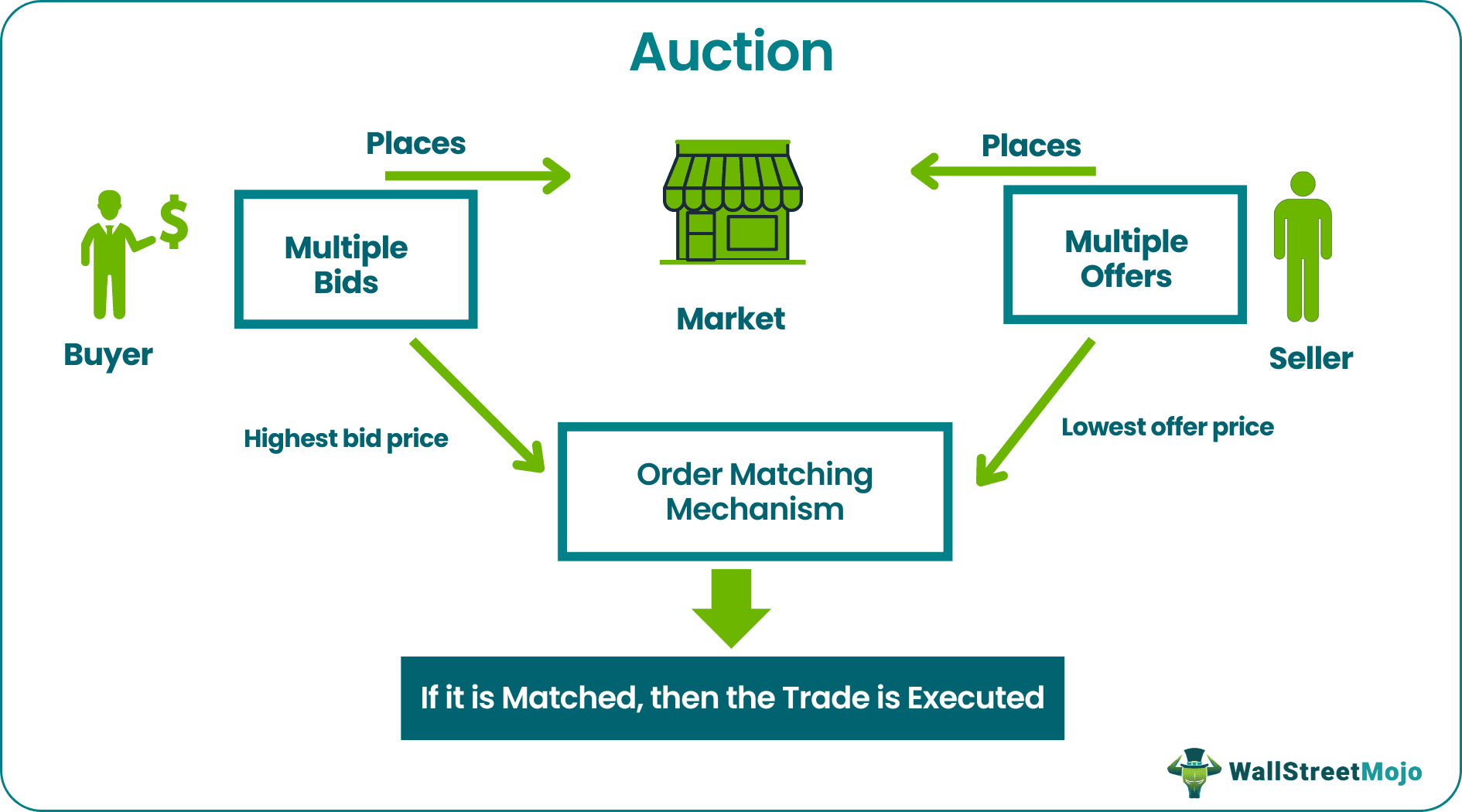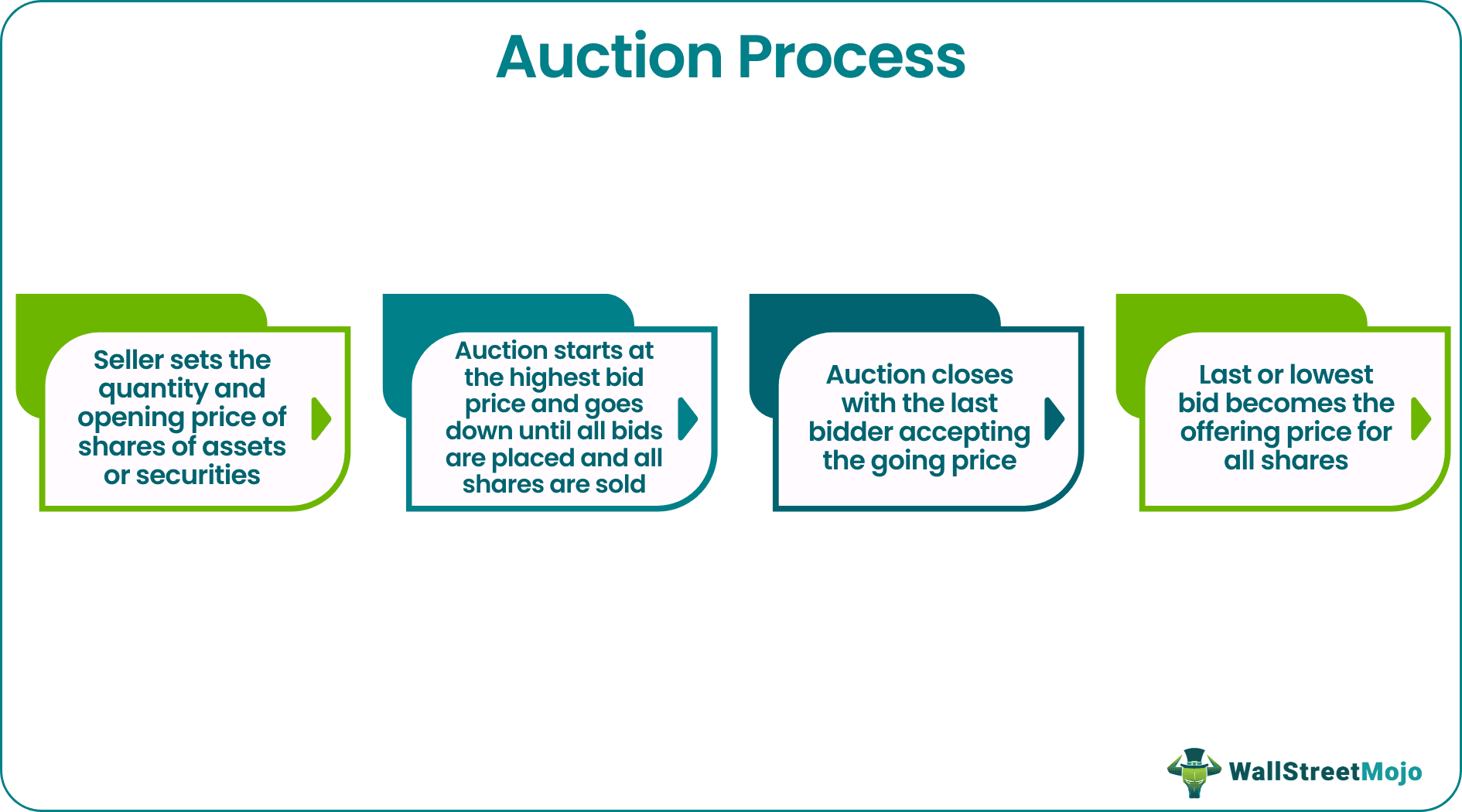Table Of Contents
Auction Definition
Auctions are bidding contests conducted by sellers. A licensed auctioneer conducts the bidding, and prospective buyers are invited. First, potential buyers are given a preview period to check and examine the assets. Then, the asset is sold to the highest bidder.

Traditionally, bidding was conducted to sell antiques, rare artifacts, and real estate. But contemporarily, bidding is employed in investment banking, government settlements, and family disputes.
Key Takeaways
- Auction is the process of selling properties, assets, and other valuables through bidding.
- In the 1900s, the art of negotiation and bidding became so popular that a school of auctioneering was established to teach professional auctioneering in the US. The Jones’ National School of Auctioneering and Oratory (Davenport, Iowa) was a pioneer in this field.
- Governments procure goods and services by conducting reverse bidding or tenders. Here, sellers compete with each other to offer the lowest price.
Auction Explained
An auction is held to sell assets and properties to interested buyers. Owners and businesses hold them. It is an open buying and selling system where buyers are invited to bid for a particular asset.

Historically, bidding was first witnessed in 500 BC in ancient Greece. In the 5th century BC, the Greek historian Herodotus records Babylonian traditions—women were auctioned—it was illegal to marry a woman without winning a bidding contest. Even a few centuries ago, enslaved people were auctioned in America, along with farms, properties, and land.
When soldiers returned from the civil war, they auctioned off their war plunders. Auctions grew exponentially during the period of the great depression. In the early 1900s America, many new schools were established that exclusively taught students how to bid. The Jones' National School of Auctioneering and Oratory was the pioneer in this field.
Potential buyers are given a preview period to check and examine the assets. This preview period is announced before the day of bidding. Then, interested buyers register themselves with the auctioneer—furnishing required details and documents—a bidder card is provided to each participant. Finally, there is a bell—that announces the start of bidding. Bidders are quickly briefed about the list of assets, and bidding commences with the declaration of the minimum base price.
Participants make subsequent bids against each other—bidding ends when all assets are sold. The highest bidder claims the possession immediately (as soon as the payment is completed).
1. Government Auctions
These public biddings are undertaken to sell property belonging to the government or federal authority. A court of law sanctions such auctions. They are either managed by the government or by an authority that conducts them on behalf of the government.
There is also a provision for the government to procure goods and services via reverse auction or reverse bidding. In reverse bidding, the sellers compete with each other instead of buyers. For example, the French Government wants to produce steel; sellers compete with each other to submit the lowest price. Here, the government is the buyer and chooses between sellers who quote different prices.
Governmental reverse bidding is also called tenders. Tenders are similar to reverse bidding, but there is a small distinction. Unlike reverse bidding, sellers are kept in the dark. The seller is not aware of other bids and pertaining details. As a result, the government gains the upper hand in negotiations.
2. International Auctions
International bidding involves parties that are situated in different parts of the world. If the asset is movable, it is sent to the highest bidder. For immovable assets like a piece of land or building, the seller immediately starts the paperwork—ensuring full transparency. Detailed information about authority and ownership is immediately sent to the buyer.
3. Online Bidding
Auctioneers use computers, smartphones, and even fax machines for online bids. Nonetheless, they ensure crisp, effective, and accurate trading. eBay introduced online bidding in 1995. Online bidding is popular because sellers access a wider range of prospective buyers.
4. Live Auctions
Live bidding is monitored very carefully. Only one piece of item is sold at a time. There are many practical difficulties associated with this format. Therefore, there is a strict limit on how much a bidder can bid; such a sale is subject to numerous legalities and processes.
This format is popularly used for charity fundraisers. They are more about goodwill and generosity and less about competitive bidding. The auctioneer introduces each item with a guiding price.
5. Property Auctions
This is the most common bidding example. Participants keep raising each other to make the highest bid. Finally, the property is sold to the highest bidder.
Examples
Let us look at a few examples to understand the bidding process.
Example #1
Tulip is a businesswoman. She is leaving the country and wants to sell assets. She appoints an auctioneer who charges $900. Tulip owns a mansion and an array of paintings and collectibles. Forty bidders attended the sale—all articles were sold off except the mansion.
Next, the auctioneer rings the bell for the house auction. Rachel makes the first bid at $300000; Julia immediately cuts her off with a $450000 offer. The mansion attracts multiple bids in quick succession—a heated battle commences back and forth between the bidders. Finally, the price reaches $720000. Subsequently, Julia makes an $800000 bid. Within seconds Rachel outbids Julia with a $900000 offer.
At this point, Julia and other buyers back out. The auctioneer makes a final call, but there are no takers. The bidding contest ends, and Rachel is the new owner of the sought-after mansion.
Example #2
Jerry Maguire is an heir to a large ancestral property. But the house needs multiple repairs. Maguire is unable to clear the overhead. He puts the property on the market and wishes to buy a smaller residence.
Maguire hires an auctioneer, but looking at the run-down condition, no one bids on the property. Sometimes, prospective buyers are hesitant and can be persuaded. Sometimes, buyers don’t want a bidding contest, fearing an inflated price. In such scenarios, the auctioneer makes a vendor set the bidding in motion. Next, Maguire tries to sell the property in a closed-door deal by contacting potential buyers directly. But this alternative proved time-consuming. Finally, it got worse; the deal collapsed.
Ultimately, Maguire budges; he is forced to reduce the asking price. As a last resort, Maguire does have the option put the house on the real estate market and give it another try using a different agent. But Maguire continues with the same agent. Finally, he enters a hard bargain and settles for whatever low price he is offered.
Frequently Asked Questions (FAQs)
It is an established system of selling properties and assets through bidding; whoever makes the highest bid procures the asset. An auctioneer conducts it.
Bidding requires a licensed auctioneer who conducts the proceedings and legal formalities. Depending on the type of assets and properties involved, an auctioneer charges between $400 and $1000.
When police raid suspected criminal enterprises, they confiscate items and durables that cannot be returned to their original owner. Such articles are sold off in open bidding. The general public can bid for a particular asset. Out-of-service police equipment and impounded cars are also auctioned off.

